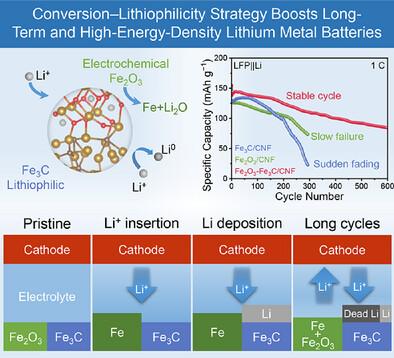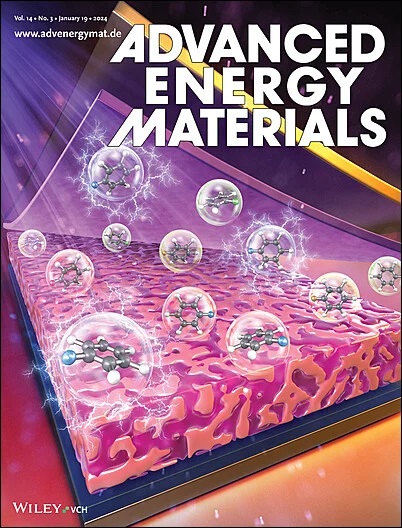Conversion–Lithiophilicity Hosts Toward Long-Term and High-Energy-Density Lithium Metal Batteries
IF 24.4
1区 材料科学
Q1 CHEMISTRY, PHYSICAL
引用次数: 0
Abstract
Lithium metal anode emerges as an ideal candidate for the next generation of high-energy-density batteries. However, challenges persist in achieving high lithium utilization rates while maintaining the demands of high energy density and extended cycle life. In this work, a novel conversion–lithiophilicity strategy is proposed to regulate the longevity of high-energy-density batteries by injecting lithium ion activity. This strategy is validated through carbon nanofiber decorated with Fe3C and Fe2O3 particles. The uniform metallic lithium deposition induced by lithiophilic Fe3C substrates has been verified through lithium deposition/stripping experiments and density functional theory calculations. The electrochemical active Fe2O3 component supplies additional anodic capacity and suppress battery degradation, as demonstrated in lithium-ion storage research and three electrode system studies. When paired with LiFePO4 cathodes at an N/P ratio of 2, the full battery showcases outstanding cycling stability over 300 cycles at 1C, with an exceptional energy density of 438 Wh kg−1 (calculated based on the cathode material and lithium content). Furthermore, the full battery delivers rapid kinetics of 124 mAh g−1 at 2C. The conversion–lithiophilicity strategy presented offers a promising avenue for the development of high-energy density and long-life lithium metal batteries.

向长期和高能量密度锂金属电池转变的亲锂性宿主
锂金属阳极是下一代高能量密度电池的理想选择。然而,在保持高能量密度和延长循环寿命的同时,实现高锂利用率仍然存在挑战。在这项工作中,提出了一种新的转换亲锂策略,通过注入锂离子活性来调节高能量密度电池的寿命。该策略通过Fe3C和Fe2O3颗粒修饰的纳米碳纤维得到验证。通过锂沉积/剥离实验和密度泛函理论计算,验证了亲锂Fe3C衬底诱导的均匀金属锂沉积。电化学活性Fe2O3组分提供额外的阳极容量,抑制电池退化,这在锂离子存储研究和三电极系统研究中得到了证明。当与N/P比为2的LiFePO4阴极配对时,整个电池在1C下超过300次循环时显示出出色的循环稳定性,具有438 Wh kg−1的特殊能量密度(基于阴极材料和锂含量计算)。此外,全电池在2C下可提供124 mAh g−1的快速动力学。所提出的转化亲锂策略为开发高密度、长寿命的锂金属电池提供了一条有前景的途径。
本文章由计算机程序翻译,如有差异,请以英文原文为准。
求助全文
约1分钟内获得全文
求助全文
来源期刊

Advanced Energy Materials
CHEMISTRY, PHYSICAL-ENERGY & FUELS
CiteScore
41.90
自引率
4.00%
发文量
889
审稿时长
1.4 months
期刊介绍:
Established in 2011, Advanced Energy Materials is an international, interdisciplinary, English-language journal that focuses on materials used in energy harvesting, conversion, and storage. It is regarded as a top-quality journal alongside Advanced Materials, Advanced Functional Materials, and Small.
With a 2022 Impact Factor of 27.8, Advanced Energy Materials is considered a prime source for the best energy-related research. The journal covers a wide range of topics in energy-related research, including organic and inorganic photovoltaics, batteries and supercapacitors, fuel cells, hydrogen generation and storage, thermoelectrics, water splitting and photocatalysis, solar fuels and thermosolar power, magnetocalorics, and piezoelectronics.
The readership of Advanced Energy Materials includes materials scientists, chemists, physicists, and engineers in both academia and industry. The journal is indexed in various databases and collections, such as Advanced Technologies & Aerospace Database, FIZ Karlsruhe, INSPEC (IET), Science Citation Index Expanded, Technology Collection, and Web of Science, among others.
 求助内容:
求助内容: 应助结果提醒方式:
应助结果提醒方式:


